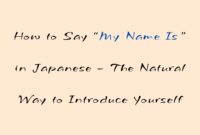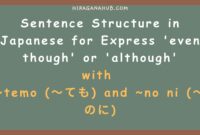Learn to Specify Places in Detail in Japanese
The Japanese language has its unique way of specifying the location of
something in detail. This article will discuss two main sentence patterns for
indicating places: “Noun 1 (person/animal) + no (の) + position + Noun 2 (place) + ga (が) + imasu
(います)” for people or animals, and “Noun 1 (object/place) + no (の) + position + Noun 2 (place) + ga (が) + arimasu
(あります)” for inanimate objects or places.
Sentence Pattern Explanation
“Imasu” Pattern
This pattern is used to indicate the existence of living beings such as people
and animals.
-
Noun 1 (person/animal): The living being whose location
is being explained. -
No (の): A particle to indicate ownership or position.
-
Position: The relative location from the second noun
(e.g., front, behind, beside). -
Noun 2 (place): The main location where the subject is
found. -
Ga imasu (がいます): Indicates the presence of living
beings.

“Arimasu” Pattern
This pattern is quite similar to “Imasu,” but it is used to indicate the
existence of inanimate objects or specific locations.
-
Noun 1 (object/place): The subject whose location is
being explained. -
No (の): Indicates a relationship or relative location.
-
Position: The relative location from the second noun
(e.g., above, beside, inside). -
Noun 2 (place): The location where the subject is found.
-
Ga arimasu (があります): Indicates the existence of
inanimate objects or locations.
Indicating the Location of People or Animals with “Imasu”
This pattern is used to state the existence of living beings like people and
animals. Let’s see some examples:
-
ミラーさんはロビのうけつけのまえにいます
(Mirā-san wa robi no uketsuke no mae ni imasu): Mr. Miller is at the lobby, in front of the reception desk. -
せんせいはかいぎしつのとなりにいます
(Sensei wa kaigishitsu no tonari ni imasu): The teacher is next to the meeting room. -
いぬはどあのまえにいます
(Inu wa doa no mae ni imasu): The dog is in front of the door.
Indicating the Location of Objects or Places with “Arimasu”
This pattern is used to state the existence of inanimate objects or locations.
Here are some examples:
-
テーブル のうえにざっしがあります
(Tēburu no ue ni zasshi ga arimasu): There is a magazine on the table. -
レストラン はABCビルのとなりにあります
(Resutoran wa ABC biru no tonari ni arimasu): The restaurant is beside the ABC building. -
ATM はぎんこうのなかにあります
(ītiemu wa ginkō no naka ni arimasu): The ATM is inside the bank.
Conversation Examples
Example 1:
-
A: すみません、ちかくのATMはどこですか?
(Sumimasen, chikaku no ītiemu wa doko desu ka?): Excuse me, where is the nearest ATM? -
B: あそこです、えきのとなりにあります
(Asoko desu, eki no tonari ni arimasu): Over there, next to the train station.
Example 2:
-
A: たなかさん、かいぎしつはどこですか?
(Tanaka-san, kaigishitsu wa doko desu ka?): Mr. Tanaka, where is the meeting room? -
B: ここからまっすぐいって、しょくどうのとなりにあります
(Koko kara massugu itte, shokudō no tonari ni arimasu): Go straight from here, it’s next to the cafeteria.
Vocabulary Used
Here is the vocabulary list from the examples above:
| Kanji | Hiragana | Romaji | Meaning |
|---|---|---|---|
| ロビ | ろび | robi | Lobby |
| うけつけ | うけつけ | uketsuke | Reception desk |
| 前 | まえ | mae | Front |
| 先生 | せんせい | sensei | Teacher |
| 会議室 | かいぎしつ | kaigishitsu | Meeting room |
| 隣 | となり | tonari | Next to |
| 犬 | いぬ | inu | Dog |
| テーブル | てぇぶる | tēburu | Table |
| 上 | うえ | ue | On |
| 雑誌 | ざっし | zasshi | Magazine |
| レストラン | れすとらん | resutoran | Restaurant |
| 銀行 | ぎんこう | ginkō | Bank |
| ビル | びる | biru | Building |
| ATM | えいてぃえーむ | eitīmū | ATM |
| 中 | なか | naka | Inside |
Conclusion
Learning Japanese requires a deep understanding of sentence structures. The
“Imasu” and “Arimasu” patterns are fundamental for effective communication. You can learn more about this language
through free online courses. Try practicing these sentence patterns to improve
your skills!
Discover more Japanese courses on online platforms and start learning in an
enjoyable way! You can understand word meanings, sentence structures, and
expand your vocabulary easily. Happy learning with hiraganahub.com!


